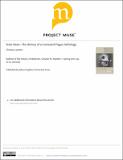Pestis minor : the history of a contested plague pathology
Abstract
Pestis minor is a pathological category that at the height of the third plague pandemic (1894–1959) fueled extensive debate and research among medical scientists. Referring to an attenuated or benign form of plague, evidence of pestis minor or pestis ambulans was produced in medical reports across the world so as to raise the question of whether the disease could survive measures against it by means of temporary transformation. Afflicting its victims only by the slightest lymphatic swellings, this theory went, the disease could thus lurk in the human body until conditions allowed it to break out again in its true, malignant form. This article draws for the first time a history of this contested pathology, the diagnostic and epidemiological questions raised by it, and the way in which it came to play a significant role in debates about the nature of plague at the turn of the nineteenth century.
Citation
Lynteris , C 2019 , ' Pestis minor : the history of a contested plague pathology ' , Bulletin of the History of Medicine , vol. 93 , no. 1 , pp. 55-81 . https://doi.org/10.1353/bhm.2019.0002
Publication
Bulletin of the History of Medicine
Status
Peer reviewed
ISSN
0007-5140Type
Journal article
Description
Research leading to this article was funded by a European Research Council Starting Grant (under the European Union’s Seventh Framework Programme/ERC grant agreement no. 336564) for the project Visual Representations of the Third Plague Pandemic (University of St Andrews and University of Cambridge).Collections
Items in the St Andrews Research Repository are protected by copyright, with all rights reserved, unless otherwise indicated.

